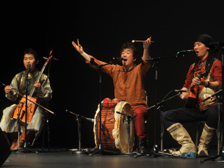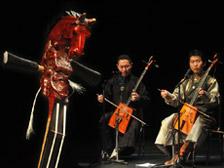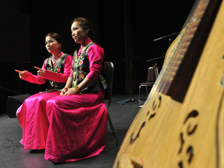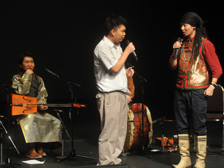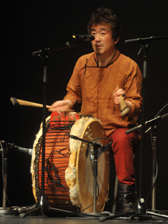City Life
Mongol musicians evoke grassland home

June 02, 2013
Ethnic Mongolians who were born and raised in nomad families make up the Horqin Ensemble from Inner Mongolia. They learned to sing and play folk music instruments from their parents and fellow folk artists from an early age. They later enrolled in professional music institutes to hone their skills.Horqin, in eastern Inner Mongolia, is known as the Land of Folksongs. Each ensemble member is able to sing while playing instruments. They have also acquired the unique Mongolian throat-singing style known as “khoomi”.
When performing “khoomi”, a singer can sing two pitches simultaneously, with a fundamental bass note and the melody sung in higher notes. Pitch is manipulated through a combination of lip and throat movements, and moving the tongue or jaw. In 2009, "khoomi" was inscribed onto the United Nations Educational, Scientific & Cultural Organisation Representative List of Intangible Cultural Heritage.
Ensemble member Baoyin, the percussionist, said some people might think “khoomi” is merely singing in a husky voice, but it is much more. Unique to Mongolians, it is a technical singing method that activates the vocal organ in ways most people have never done, he said.
One of the traditional Mongolian instruments is called a "morin kuur", or horse-head fiddle. It is a cello-like instrument with a horse head carved on its scroll. A sad legend describes its origins: A shepherd grieving for his dead horse used its remains to make the original two-string fiddle.
As the story goes, he used the horse’s leg bone as the fiddle’s neck, its skull as the soundbox with its skin mounted on it, hair from its tail as strings, and the bridle as the bow. The instrument produces an expansive, sorrowful and soulful sound.
Baoyin’s innovative goat-skin drumset - mounted with a wooden block and tambourine - adds a contemporary sound to traditional Mongolian ethnic music. He can beat on any of its surfaces to make the sound of a Mongolian horse running across the plains more vivid.
The ensemble’s love of music and their homeland is trumpeted in their performance. The Leisure & Cultural Services Department recently invited them to perform in Hong Kong, and share their experience with local students. They also perform frequently throughout China and abroad to share and promote Mongolian music and culture.
Visit the Leisure & Cultural Services Department’s website or download the “My Culture” mobile application to keep abreast of other engaging ethnic performances.
